Judi Lynn
Judi Lynn's JournalLula's Free And He's Promising to Fight
The former president will boost Brazil’s left, but will he also help unite the far right?
By Michael Fox TODAY 3:02 PM
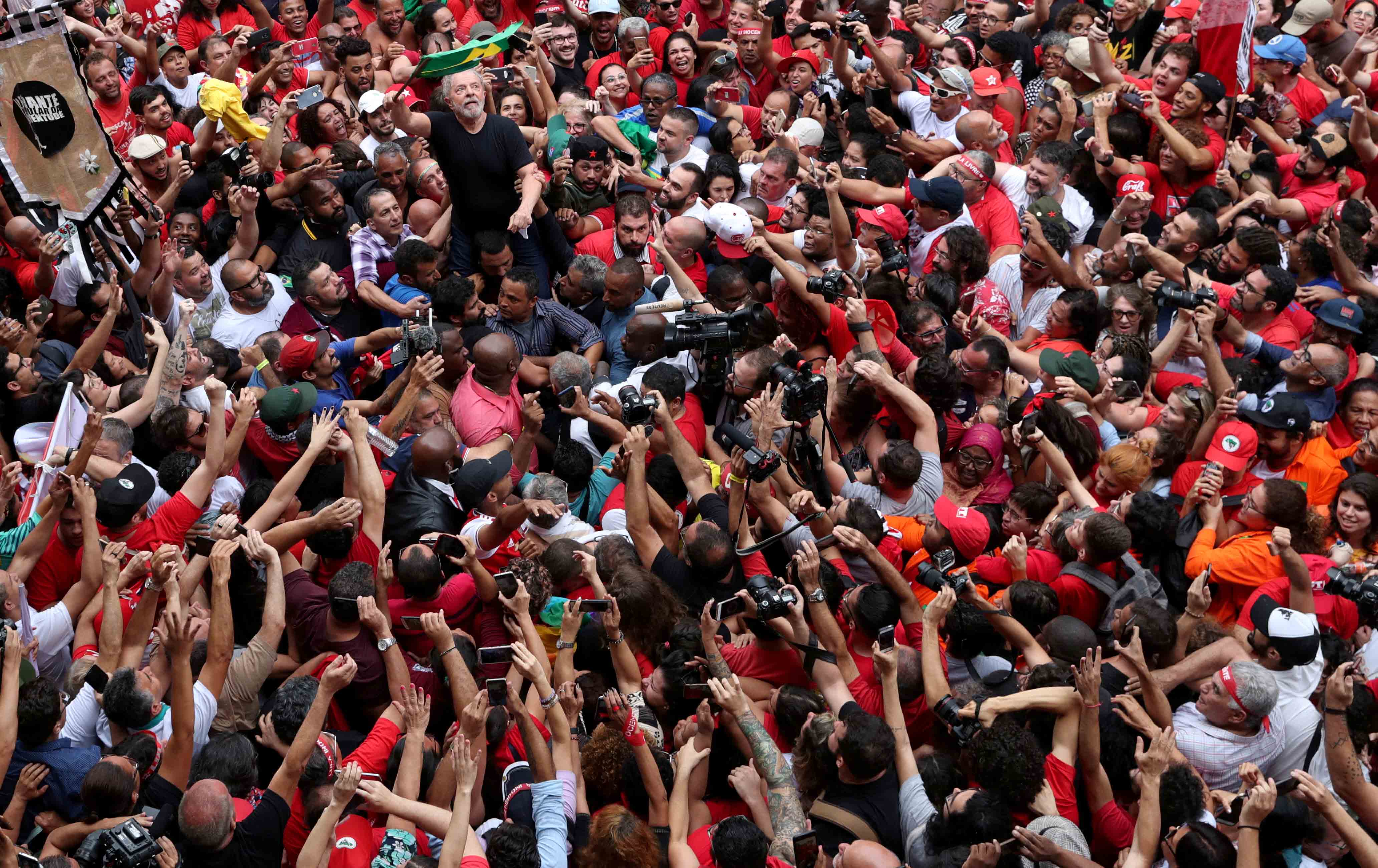
Former Brazilian president Luiz Inacio Lula da Silva waves the Brazilian flag after being released from prison, in Sao Bernardo do Campo, November 9. (Amanda Perobelli / Reuters)
Curitiba, Brazil—Lula’s freedom was never a foregone conclusion—even after Brazil’s Supreme Court decided last Thursday that it was unconstitutional to jail defendants before they had exhausted their appeals. This included former president Luiz Inacio Lula da Silva and roughly another 5,000 people in detention around the country. Legally, they should have been freed, but justice, particularly in Brazil, doesn’t just happen.
After the Supreme Court decision, leaders of the Landless Workers Movement and Lula’s Workers Party called for supporters to descend on the southern Brazilian city of Curitiba. People poured into the Santa Candida residential neighborhood surrounding the prison and joined a community of Lula supporters who had been protesting there for 19 months.
In front of the jail, rows of cameras on tripods were pointed at the entrance, waiting. Lula’s lawyers visited him in the morning, and announced that they had asked a local Curitiba court to release him immediately.
Spontaneous cheers and “Free Lula” chants erupted every few minutes from a crowd that would grow to more than 20,000 people, according to organizers. People in red shirts walked in half-euphoria, half-daze, still disbelieving that Lula might really be free within a few hours.
More:
https://www.thenation.com/article/brazil-lula-curitiba/
The Bolivian Coup Is Not a Coup--Because US Wanted It to Happen
NOVEMBER 11, 2019
ALAN MACLEOD

Army generals appearing on television to demand the resignation and arrest of an elected civilian head of state seems like a textbook example of a coup. And yet that is certainly not how corporate media are presenting the weekend’s events in Bolivia.
No establishment outlet framed the action as a coup; instead, President Evo Morales “resigned” (ABC News, 11/10/19), amid widespread “protests” (CBS News, 11/10/19) from an “infuriated population” (New York Times, 11/10/19) angry at the “election fraud” (Fox News, 11/10/19) of the “full-blown dictatorship” (Miami Herald, 11/9/19). When the word “coup” is used at all, it comes only as an accusation from Morales or another official from his government, which corporate media have been demonizing since his election in 2006 (FAIR.org, 5/6/09, 8/1/12, 4/11/19).
The New York Times (11/10/19) did not hide its approval at events, presenting Morales as a power-hungry despot who had finally “lost his grip on power,” claiming he was “besieged by protests” and “abandoned by allies” like the security services. His authoritarian tendencies, the news article claimed, “worried critics and many supporters for years,” and allowed one source to claim that his overthrow marked “the end of tyranny” for Bolivia. With an apparent nod to balance, it did note that Morales “admitted no wrongdoing” and claimed he was a “victim of a coup.” By that point, however, the well had been thoroughly poisoned.
CNN (11/10/19) dismissed the results of the recent election, where Bolivia gave Morales another term in office, as beset with “accusations of election fraud,” presenting them as a farce where “Morales declared himself the winner.” Time’s report (11/10/19) presented the catalyst for his “resignation” as “protests” and “fraud allegations,” rather than being forced at gunpoint by the military. Meanwhile, CBS News (11/10/19) did not even include the word “allegations,” its headline reading, “Bolivian President Evo Morales Resigns After Election Fraud and Protests.”
Delegitimizing foreign elections where the “wrong” person wins, of course, is a favorite pastime of corporate media (FAIR.org, 5/23/18). There is a great deal of uncritical acceptance of the Organization of American States’ (OAS) opinions on elections, including in coverage of Bolivia’s October vote (e.g., BBC, 11/10/19; Vox, 11/10/19; Voice of America, 11/10/19), despite the lack of evidence to back up its assertions. No mainstream outlet warned its readers that the OAS is a Cold War organization, explicitly set up to halt the spread of leftist governments. In 1962, for example, it passed an official resolution claiming that the Cuban government was “incompatible with the principles and objectives of the inter-American system.” Furthermore, the organization is bankrolled by the US government; indeed, in justifying its continued funding, US AID argued that the OAS is a crucial tool in “promot[ing] US interests in the Western hemisphere by countering the influence of anti-US countries” like Bolivia.
In contrast, there was no coverage at all in US corporate media of the detailed new report from the independent Washington-based think tank CEPR, which claimed that the election results were “consistent” with the win totals announced. There was also scant mention of the kidnapping and torture of elected officials, the ransacking of Morales’ house, the burning of public buildings and of the indigenous Wiphala flag, all of which were widely shared on social media and would have suggested a very different interpretation of events.
More:
https://fair.org/home/the-bolivian-coup-is-not-a-coup-because-us-wanted-it-to-happen/
Also posted this in Editorials and other articles;
https://www.democraticunderground.com/1016242399
Bolivia's Coup Threatens the Struggle for Social Liberation and Economic Justice
by Olivia Arigho-Stiles
@OliviaArigho
The Bolivian president, Evo Morales, has been forced from office in a coup following two weeks of civil unrest and a disputed presidential election.
It is not the US-backed coup many have declared on social media, reading from the script of the recent past in Latin America. But it is a coup nonetheless, steered by the urban middle classes and ultra-right regional elites in Bolivia. It should be understood, in part, as a backlash against the redistributive and pro-indigenous policies promulgated by Morales over the past 14 years.
The decisive moment came when the head of the Bolivian armed forces on Sunday ‘suggested’ that Morales resign following a police mutiny in cities across the country over the weekend.
Morales’s house has since been ransacked (along with his sister’s), the ex-president of the electoral authority has been arrested and paraded on television, and groups of anti-government protesters have taken to the streets to burn the Wiphala, the flag representing indigenous peoples in the Andes.
Morales, the first indigenous president of Bolivia and a former coca grower, was first elected in 2005 with his social movement backed party, the Movimiento al Socialismo (MAS). Under his tenure Bolivia has slashed poverty rates, reduced inequality, overseen economic growth while rejecting IMF debt bondage, and nationalised key industries.
Bolivia also has crucially seen the ‘indigenisation’ of the state – the elevation of Bolivia’s indigenous peoples and the centring of indigenous belief systems in public life. Morales has made powerful statements on the global stage in favour of redistribution of wealth, the recognition of indigenous rights and protection of the environment. In 2010, Morales championed the ‘Rights of Mother Earth’ law which recognises the earth as a political subject enshrined with, among other things, a right to life.
None of this was without opposition from traditional white-mestizo (mixed race) elites and international capital. Bolivia is Latin America’s poorest country, with a long history of economic exploitation by foreign powers and racist discrimination against its majority indigenous population.
More:
https://novaramedia.com/2019/11/12/bolivias-coup-threatens-the-struggle-for-social-liberation-and-economic-justice/
Bolsonaro and Lula Exchange Verbal Attacks
The President first attacked on social media; Lula attacked during his speeches
Nov.11.2019 1:19PM
In his first time talking about former President Luiz Inacio Lula da Silva's release from prison, President Jair Bolsonaro (PSL) called the petista a scoundrel, without mentioning his name. He later said that one should not "compromise with a president."
Bolsonaro posted a video in honor of Justice Minister Sergio Moro - who, when a Lava Jato judge, convicted Lula in 2018 for corruption. Moro, in turn, lamented the ruling of the Supreme Court.
Lula benefited from the Supreme Court decision that, on Thursday (7), changed the case law on the arrest soon after a state-level appeal. But he is still convicted by the case of the Guarujá tríplex. He is accused of taking bribes by the OAS for contracts with Petrobras, which he denies.
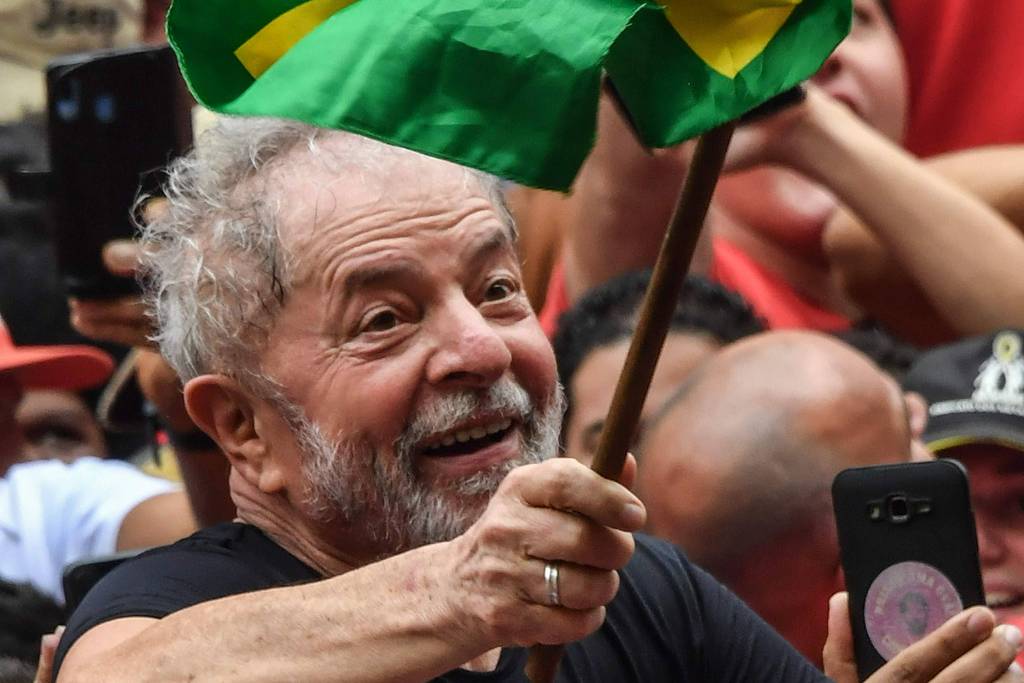
Brazilian former president (2003-2011) Luiz Inacio Lula da Silva waves a Brazilian flag as he is carried on the shoulders through the crowd of supporters during a gathering outside the metalworkers' union building in Sao Bernardo do Campo, in metropolitan Sao Paulo, Brazil, on November 9, 2019. - Brazil's leftist icon Luiz Inacio Lula da Silva walked free from jail Friday after a year and a half behind bars for corruption following a court ruling that could release thousands of convicts. (Photo by Nelson ALMEIDA / AFP) - AFP
His political situation may change. Another court ruling will examine Moro's suspicion. If accepted, these lawsuits against Lula go back to the first instance, cleaning his record and thereby making him eligible to be elected.
More:
https://www1.folha.uol.com.br/internacional/en/brazil/2019/11/bolsonaro-and-lula-exchange-verbal-attacks.shtml
Your information carries so much weight! I am so grateful to have learned the name of this man,
the new fascist tyrant, and sadist, greedy, murderous criminal who's the extension of Branko Marinkovic, connected through his traitorous parents to the Croatian Nazis. Branko Marinkovic was for so long active in organizing and operating the gangs of violent right-wing racist white storm troopers, down to handing out clubs and bats from his office to gangster walk-ins.
They periodically go on rampages, clobbering and beating stuffings out of "####ing Indians" they see on the streets, or driving directly to their neighborhoods on the outskirts of towns and destroy everything in their paths there.






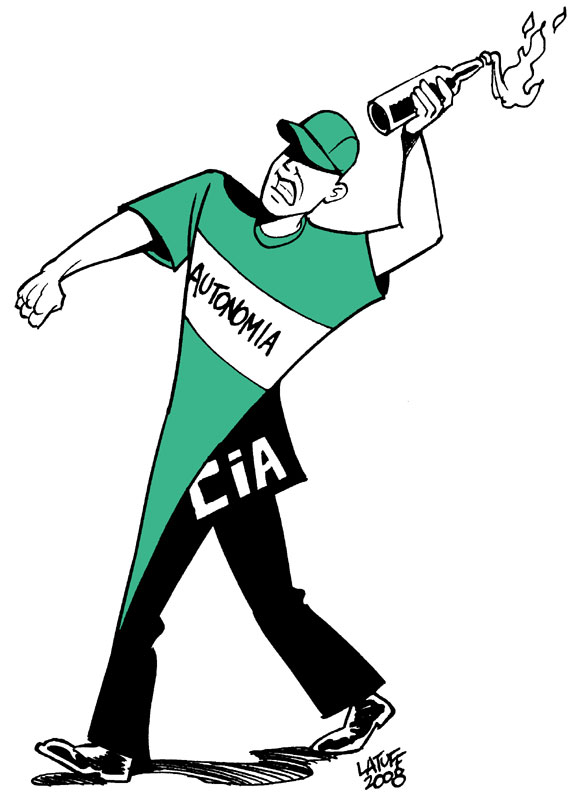
Here's an article written in 2008, and it will show nothing has changed beyond intensification of the open violence by the nazi youth movement, even though the standard of living has improved steadily for the great majority of the poor, and downtrodden, right in their own homeland, indigenous people, the native Bolivians.
ABIDING IN BOLIVIA
CARAJO
http://casa-del-duderino.blogspot.com/2008/09/santa-cruz-republica-de-mierda.html
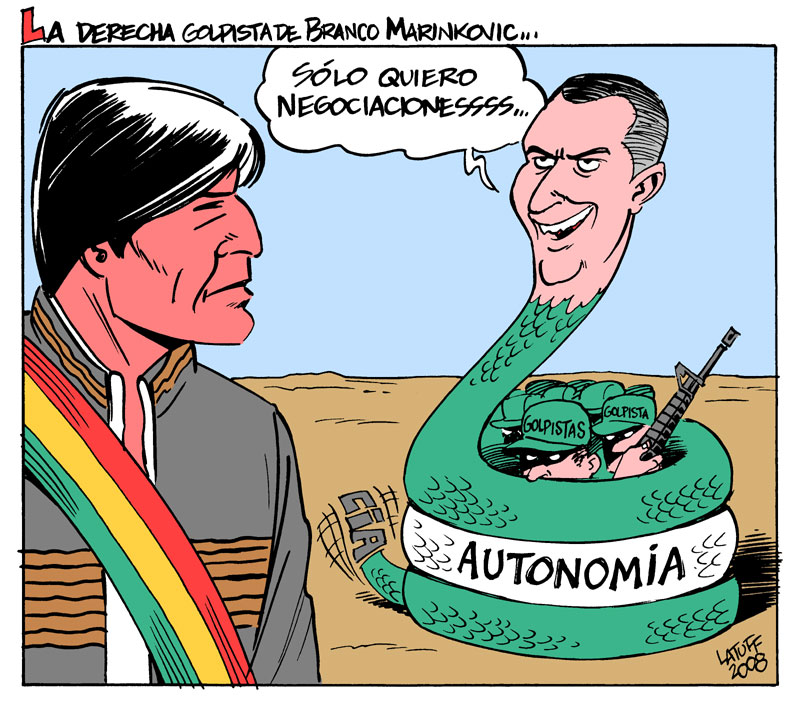

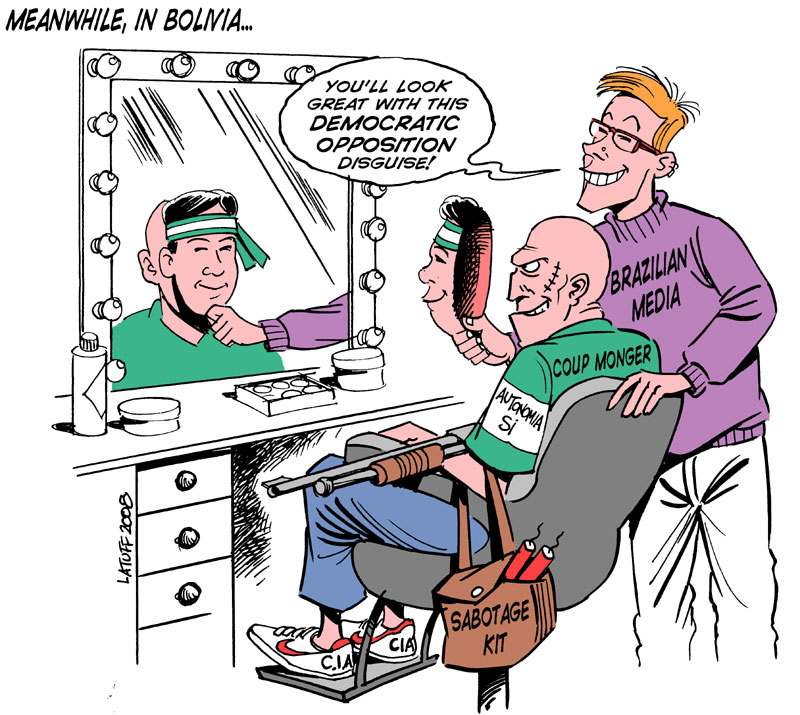

I just found the following article, doing a search for Camacho and Marinkovic:
Google translate:
They reveal that Camacho is transported in Marinkovic's vehicle in La Paz
07 NOVEMBER 2019 19:09 H.

Éxito Noticias, November 7, 2019.- The Minister of Government, Carlos Romero, in contact with radio Éxito revealed that the civic leader from Mendoza Luis Fernando Camacho who arrived at the Government headquarters last Wednesday night is transported in a vehicle of Mr. Branko Marinkovic and questioned the proceeding of the resources with which this campaign of “destabilization” of the Government is solved.
"Do you know that the car in which it moves is Branko Marinkociv? If it is in the car of Branco Marinkovic, a separatist who at the time invented the theory that you change them are superior and lower collas and that you had to leave this country in two, this Mr. Camacho moves in his vehicle. Look, we are giving him security and God wants nothing to happen, hopefully it will not provoke, ”Romero said.
Marinkovic, the former president of the Pro Santa Cruz Committee and accused of the Terrorism case fled the country and is currently investigated because the commission detected 14 offshore companies belonging to his family and was syndicated as one of the main suspects in financing a group of mercenaries to try to divide Bolivia in 2009
“We have made many mistakes, but from there to make a political turn to be part of a conspiracy. In a conspiracy that has so much money, Someone ask yourself, how much does this mobilization cost each day? 100 thousand dollars out there is short, ”said the minister questioning the cost of sustaining this mobilization for 15 days of uninterrupted unemployment.
Romero reproached the attitude of the civic leader who once said that: "The government minister who looks after his president I do not need to protect me," and now he is protected by his integrity at the seat of government, "imagine the intolerance of such arrogant, arrogant people we are dealing with, ”the authority concluded.
https://www.exitonoticias.com.bo/articulo/politica/romero-revela-camacho-transporta-vehiculo-marinkovic-paz/20191107190954042023.html
Thank goodness for your information. It gives us so much more to keep in mind. The new name clearly is powerful already. Thank you, and thank you, sandensea.
Salvadoran massacre victims still hunting 'truth and justice' 38 years later
NOVEMBER 9, 2019 / 2:04 PM / UPDATED 11 HOURS AGO
Nelson Renteria
4 MIN READ
CACAOPERA, El Salvador (Reuters) - Fidel Perez has abandoned his farm for the day to look on as investigators work in a remote cemetery in this Central American country, seeking answers to one of many tragedies in the Salvadoran civil war - and the remains of his mother and sister.
For Perez, now 43, the investigation marks a return to a dark day when he was seven years old, huddled in a cave with his family and neighbors. Then soldiers threw in a grenade.
It was December 1981, during a military operation in Morazan, at the dawn of the long and bloody civil war that claimed tens of thousands of lives.
Perez fainted in the explosion. When he regained consciousness, he saw that his mother and sister had been killed in the attack, along with 10 others.
. . .
According to a U.N. report, soldiers tortured and executed more than a thousand residents of El Mozote and surrounding hamlets in the Morazán department, 180 km (110 miles) northeast of San Salvador, as they searched for guerrillas in December 1981.
More:
https://www.reuters.com/article/us-elsalvador-politics/salvadoran-massacre-victims-still-hunting-truth-and-justice-38-years-later-idUSKBN1XJ0H8?rpc=401&
~ ~ ~
Wikipedia:
The El Mozote Massacre took place in and around the village of El Mozote, in Morazán department, El Salvador, on December 11, 1981 when the Salvadoran Army killed more than 800 civilians[1] during the Salvadoran Civil War. The El Mozote massacre was preceded by the Indigenous Genocide massacre of 1932, the Student massacre of 1975, and the Óscar Romero funeral massacre and Sumpul River massacre in 1980. It was followed by the El Calabozo massacre in 1982, the Tenango - Guadalupe massacre and Tenancingo - Copapayo massacre in 1983, and the Guaslinga - Los Llanitos massacre in 1984.
In December 2011, the Salvadoran government apologized for the massacre,[2] the largest in Latin America in modern times.[3]
. . .
December 11 and 12
Early the next morning, the soldiers reassembled the entire village in the square. They separated the men from the women and children and locked them in separate groups in the church, the convent, and various houses.[9]
During the morning, they proceeded to interrogate, torture, and execute the men in several locations.[10] Around noon, they began taking the women and older girls in groups, separating them from their children and murdering them with machine guns after raping them.[11] Girls as young as 10 were raped, and soldiers were reportedly heard bragging how they especially liked the 12-year-old girls.[12] Finally, they killed the children at first by slitting their throats, and later by hanging them from trees; one child killed in this manner was reportedly two years old.[13] After killing the entire population, the soldiers set fire to the buildings.
The soldiers remained in El Mozote that night but, the next day, went to the village of Los Toriles and carried out a further massacre. Men, women, and children were taken from their homes, lined up, robbed, and shot, and their homes then set ablaze.[14]
Initial reports and controversy
News of the massacre first appeared in the world media on January 27, 1982, in reports published by The New York Times[15] and The Washington Post. Raymond Bonner wrote in the Times of seeing "the charred skulls and bones of dozens of bodies buried under burned-out roofs, beams, and shattered tiles".[15] The villagers gave Bonner a list of 733 names, mostly children, women, and old people, all of whom, they claimed, had been murdered by government soldiers.[15][16]
Alma Guillermoprieto of the Post, who visited the village separately a few days later, wrote of "dozens of decomposing bodies still seen beneath the rubble and lying in nearby fields, despite the month that has passed since the incident... countless bits of bones—skulls, rib cages, femurs, a spinal column—poked out of the rubble".[17]
Both reporters cited Rufina Amaya, a witness who had escaped into a tree during the attack. She told the reporters that the army had killed her husband and her four children, the youngest of whom was eight months old, and they lit the bodies on fire.[15]
Ruins of a burned building.
Salvadoran army and government leaders denied the reports and officials of the Reagan administration called them "gross exaggerations".[17] The Associated Press reported that "the U.S. Embassy disputed the reports, saying its own investigation had found... that no more than 300 people had lived in El Mozote."[16]
More:
https://en.wikipedia.org/wiki/El_Mozote_massacre
~ ~ ~
Research and The Massacre at El Mozote: How the U.S. justified its support for the Salvadoran Military
By Rachel BierlyMarch 7, 2019

There is no justification to murder civilians in any circumstance. However, perhaps just as heinous a crime is to support any individual or organization who commits these murders or look the other way when they are committed. This is what the United States did under the Raegan Administration in the 1981 massacre at El Mozote. In Mark Danner’s collection of accounts and analysis of this massacre in his book titled The Massacre at El Mozote, he discusses the way in which the U.S let its fear of communism rationalize its action of strategically overlooking the horror that was invoked upon El Mozote. The U.S. played a tremendous role in allowing these tragic human rights violations to happen through monetary and weapons provisions, the U.S. training of Salvadoran military members, and the ignorance and discrediting of research.
Following the successful left-wing Sandinista movement in Nicaragua, the U.S. fought actively to achieve its goal of preventing communism regimes. When left-wing guerilla groups formed the Farabundo Marti National Liberation Front (FMLN) in El Salvador, the U.S. helped to fund the Salvadoran military, provide arms for soldiers, and train Salvadoran troops. Members of the Atlacatl Battalion were trained by U.S. Special Forces (38) and the battalion was assigned at least 10 American advisors (119). The U.S. was practiced at supporting regimes sympathetic to U.S. goals, though arguably without success (e.g. 1954 CIA intervention in Guatemala, 1961 Bay of Pigs Invasion). Therefore, the U.S. should have been aware of the potential catastrophes of under-arming, under-training, or under-funding a movement.
The American training was not as “elite” as the press reported. In fact, one of the Special Forces trainers explained that members of the Atlacatl Battalion “‘had no specialized training’” (49). Without debating the ethics of U.S. support for foreign militaries, failing to properly train or support a military division had previously resulted in severe consequences. The under-trained Salvadoran soldiers were responsible for the massacre of 800 civilians at El Mozote. Consequently, the U.S. was also responsible due to its failure to sufficiently train the battalion, and for the funding and arms provided to the Salvadoran soldiers. In the aftermath of El Mozote, Danner, a notable scholar on Latin American politics and foreign affairs and author of The Massacre at El Mozote emphasized the importance of facts, and how overlooking and discounting research led the U.S. to continue allowing the Salvadoran regime to kill more innocent people.
In recent years, the veracity of facts, a phrase that would once have seemed redundant, has become controversial. It was not much different in 1981 El Salvador. The U.S. Administration dismissed research due to a lack of concrete evidence, resulting in the continued ignorance of the reality of the Salvadoran regime. Salvadoran radio station Venceremos which, though based on facts, was dismissed by the U.S. Government as nothing more than propaganda (87). William L. Wipfler, director of the human-rights office of the National Council of Churches in New York was one of the first people to research the massacre. Wipfler reached out to the U.S. Ambassador Deane Hinton, Amnesty International and other human rights organizations (86).
More:
https://www.panoramas.pitt.edu/opinion-and-interviews/research-and-massacre-el-mozote-how-us-justified-its-support-salvadoran
Film probes history of Native Americans in the US military
Russell Contreras, Associated Press
Updated 10:49 am CST, Saturday, November 9, 2019

Photo: Jeff Robbins, AP
IMAGE 1 OF 7
In this July 8, 1986, file photo, World War II Navajo veterans and supporters march through the reservation in a show of solidarity against giving up any of their land to the Hopis in Arizona. "The Warrior Tradition," a new film set to air on most PBS stations Monday, Nov. 11, 2019, examines the history of Native Americans in the U.S. military since World War I.
ALBUQUERQUE, N.M. (AP) — Before Chuck Boers joined the U.S. Army, the Lipan Apache member was given his family's eagle feathers. The feathers had been carried by his great-great-great-grandfather on his rifle when he was an Apache scout.
They also were carried by relatives who fought in World War I, World War II, Korea and Vietnam. In 2004, Boers had the feathers with him during the Battle of Fallujah in Iraq. "I felt like I had my family with me to protect me," he said.
"The Warrior Tradition," a new film set to air on PBS, examines the complex history of Native Americans in the U.S. military since World War I and how their service transformed the lives for Native Americans from various tribes. Through interviews with veterans and using archival footage, the documentary probes the complicated relationship Native Americans had with military service and how they used it to press for civil rights.
. . .
At the onset of World War I, the first generation of Native Americans after the so-called Indian Wars began joining the U.S. Army even though they weren't considered citizens or allowed to vote. Returning veterans, and also those from World War II, earned accolades for their service. For example, Comanche and Navajo Code Talkers in World War II were credited with passing secrets amid hostile fighting.
The returning veterans began demanding the right to vote and fought against discrimination. For example, Miguel Trujillo Sr., a Marine sergeant in World War II and a member of Isleta Pueblo in New Mexico, returned and waged a legal battle to overturn that state's law that barred American Indians living on reservations from participating in elections.
More:
https://www.chron.com/news/us/article/Film-probes-history-of-Native-Americans-in-the-US-14822599.php
This Bobtail Squid Might Be the Cutest Thing in the Ocean
JULY 2, 2019

© DOUG PERRINE / SEAPICS.COM
Katie Hogge
AUTHOR
Gather ‘round, ocean lovers…we found it. We found what we’re pretty positive could be the cutest cephalopod in the entire ocean, and its name is the Hawaiian bobtail squid (Euprymna scolopes). From their favorite foods to their BFF status with a special little set of bacteria, check out these six things to know about one of the most adorable invertebrates in the entire ocean: the Hawaiian bobtail squid.
More:
https://oceanconservancy.org/blog/2019/07/02/bobtail-squid-might-cutest-thing-ocean/
Colombia's trial of the century: prosecution interrogates Uribe's fixer
by Adriaan Alsema November 5, 2019
The fixer of former President Alvaro Uribe returned to Colombia to be heard by prosecutors on Tuesday about his role in the alleged fraud and bribery practices of his boss.
Mafia lawyer and self-proclaimed “gangstattorney” Diego Cadena returned to Colombia on Monday to comply with the prosecution order to attend Tuesday’s 9AM hearing.
Cadena was called in for a hearing after the Supreme Court ordered the prosecution to add bribery to the growing list of crimes allegedly committed by the mafia lawyer.
. . .
The United States’ Department of Justice (DOJ) works closely with the prosecution and has reportedly refused to cooperate with the Supreme Court to gather evidence of Cadena’s alleged visits to US prisons.
More:
https://colombiareports.com/colombias-trial-of-the-century-prosecution-interrogates-uribes-fixer/
Police investigate acid attack on Milwaukee's south side as a hate crime; suspect in custody
Police investigate acid attack on Milwaukee's south side as a hate crime; suspect in custody
Sophie Carson, Milwaukee Journal Sentinel
Published 3:01 p.m. CT Nov. 2, 2019 | Updated 12:20 p.m. CT Nov. 3, 2019
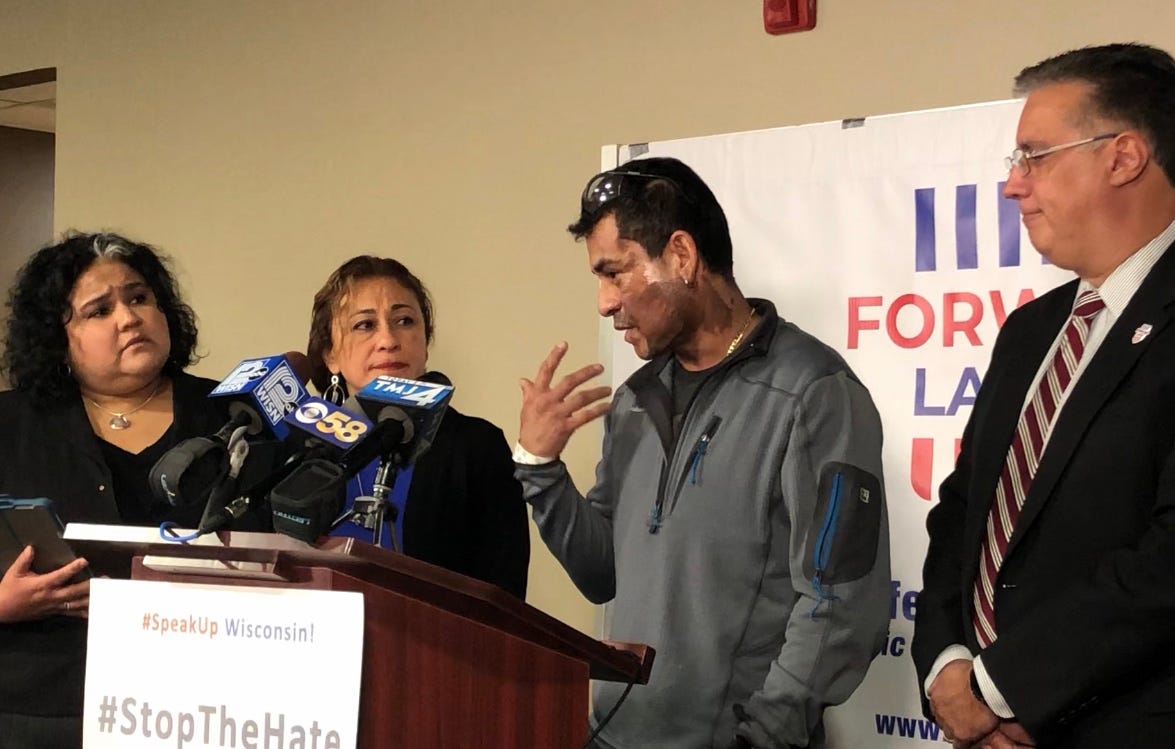
A Milwaukee man who suffered second-degree burns to his face in an acid attack Friday said Saturday he's now scared to walk around in his own city.
Mahud Villalaz, 42, on Saturday remained stunned by his encounter on Milwaukee's south side with a man at a bus stop who began berating him and then threw acid onto his face from a metal bottle.
Police said early Sunday that they had arrested a 61-year-old man in connection with an "aggravated battery" near the same location on Friday.
Villalaz's family released a statement thanking police for an arrest in the case.
"We wish to thank Chief Alfonso Morales and all the professionals at the Milwaukee Police Department for their efforts in bringing the attacker to justice," the statement reads.
On Saturday Villalaz said he no longer felt safe.
"I feel scared being an American citizen. I feel scared that I cannot feel protected in my own country with my neighbors," Villalaz told reporters at a news conference Saturday where he spoke in both Spanish and English.
More:
https://www.jsonline.com/story/news/local/2019/11/02/milwaukee-battery-acid-attack-man-burned-police-looking-suspect/4140669002/
Profile Information
Member since: 2002Number of posts: 160,515